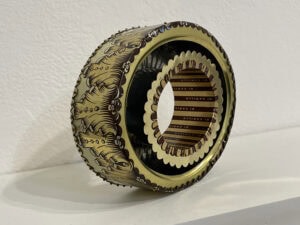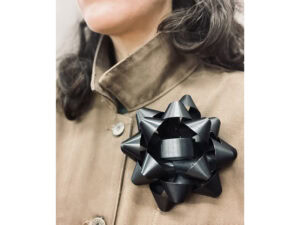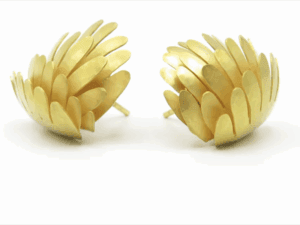The first wall text you encounter in the jewelry gallery at the V&A museum in London is this no-nonsense, factual statement of what you’ll see: ‘These displays begin in ancient Egypt, Greece and Rome. Thereafter they are devoted mainly to the story of western jewelry since medieval times.’ On the lower level, the display begins in 1500 BC and continues to the present, while on the upper level you find watches, swords, gold boxes and what the text calls ‘European traditional jewellery.’ Drawers hold sentimental and political jewelry, while large-print books and computers address both luddites and technophiles, satisfying any visitor who might want to know more.

The initial display (if you enter through what is the ‘proper’ entrance) is called, ‘From Cradle to Grave: Jewellery adorns and protects the wearer in the journey through life.’ This is a kind of orientation display, evoking the various powers and social roles of jewelry, emphasizing it as a form of protection, a sign of love and affection, a sign of wealth and status, and a sign of mourning. Jewelry from different periods is mixed together, most having been produced between 1500 and 1900. Everything is displayed on little pins and projected into space against a plain background, with a number that directs you to the object’s information underneath. Brief texts outline each role that jewelry has played historically. The (notable) omission here is jewelry’s function as art, as creative expression – what we might call contemporary jewelry. From this display you would not know that the previous 50 years of contemporary jewelry, not to mention a century of art jewelry, had actually occurred. This is a somewhat strange absence, given that one side of the gallery is dedicated to exactly this story.
After this introductory moment, the display does exactly what is promised in the wall text. Starting at 1500 BC, we are introduced to various examples of historic jewelry. The hang in the wall cases is quite dense, each object pinned against a black fabric panel, with certain key objects projected into space on pins. The jewelry is unimpeded by text, accompanied only by the number that refers you to the object label and interpretative text on the panels below. In contrast, the central cases feature a more dramatic display;, objects held at eye height on thin metal stands. If the wall cases are organized by didactic concerns and seek a kind of encyclopedic coverage, the central cases are all about splendor and spectacle, jewelry as singular objects. It is an effective juxtaposition and I imagine a good solution to the V&A’s dual legacy as an institution of instruction (seen in its weird focus on materials and technique, for example) and a repository of special treasures that delight and amaze visitors.
But there is something deadening about the didactic display, this insistent emphasis on typology and classification. It eventually overcomes your ability to see individual jewels and appreciate what is special about them. If the V&A suffers from an embarrassment of riches – more jewelry than it knows what to do with – this gallery also offers a surprising boredom of riches. It is possible to simply have too much jewelry and to display it in a manner that denies what makes it interesting. Indeed, the display doesn’t pay much attention to these objects as jewelry. In the wall cases, within the taxonomic displays, the jewelry is pinned against fabric backdrops with no functional distinction made: rings, bracelets, necklaces, pendants, earrings and diadems all get the same treatment, flattened into two-dimensional images. It is only when the jewelry is singled out for attention in the central cases that the physicality of the objects and their relationship to the body, is allowed and highlighted.
Still, the information featured in these displays is captivating, if you take the time to read it. One example: cast-iron jewelry from 1800 to 1830. The display of fourteen objects is accompanied by a fascinating text about its production, consumption and style:
‘First made in 1806, the year that Napoleon defeated Prussia, it soon became a symbol of patriotism. During the wars of liberation in 1813-15 women donated their gold jewellery in exchange for iron inscribed “I gave gold for iron”. The simplicity of early Berlin ironwork embodied the virtue of modesty valued in Prussian society. The jewellery used a range of naturalistic and stylised motifs, including classical relief scenes and portraits. These classical elements were taken from ancient gems and intaglios and from Josiah Wedgwood’s jasperware (displayed nearby).’
As if that isn’t enough, a second text offers the following:
‘The transformation of cast iron, a dark metal of little value, into a fashionable product was an important Prussian manufacturing success. Factories became adept at casting the small, delicate parts that were assembled to create the jewellery. A renewed interest in the medieval past throughout Europe brought stylistic change. After 1815, the Neo-classical designs of earlier Berlin ironwork were replaced by Gothic motifs such as the fine-pointed arch, the trefoil and the quatrefoil. The jewellery gained an international following, with demand peaking in the 1830s when Berlin alone had 27 foundries and manufacture had spread to France and Austria.’
Imagine this level of information multiplied along both walls of the gallery and presenting the story of jewelry over 2500 years. It is an impressive and overwhelming performance.
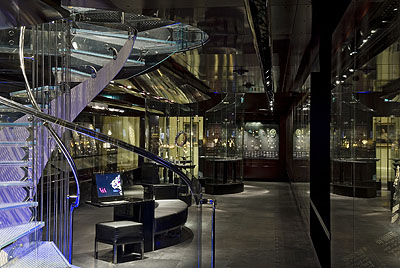
What is really notable about this display is its insistence on placing commercial or conventional jewelry, made with precious materials, alongside what we would call contemporary jewelry. With its focus on jewelry as it is defined at the outset – body adornment with a range of functions – the display makes no judgments about quality or distinctions of worth. This is underlined by the jewelry’s subservience to chronology as the exhibition’s ultimate structuring element: the period 1920 to 1950 has arts and crafts jewelry still being made, even though the peak of the movement has been and gone, as well as Bauhaus modernist experiments, as well as gold and diamond jewelry by the likes of Van Cleef & Arpels. During these years, all these objects are produced, they are purchased and worn, they signify. That they signify quite different things, or represent different issues, is not ignored by the display, but neither is it turned into a rationale for keeping them separate. Chronology enables the differences to be reconciled, at least within these display cases.
I find this approach quite productive, as it gives a wide context for the contemporary jewelry experiments that became more radical as the twentieth century progressed. It is interesting to be able to compare the Scandinavian aesthetics and materials of the 1950s with the flora, fauna and figures that were ornamenting precious materials jewelry during that same decade. It heightens the effects of the work included in the 1961 International Exhibition of Modern Jewellery, held at the Goldsmiths’ Hall in London, much of it made by artists to emphasize the role of creative imagination in jewelry, to see it alongside the commercial work available at the same time.
From 1960, however, this dual story drops away and the focus is held firmly on contemporary jewelry practices. (I found myself regretting this, and wish that the curators had kept this fertile aspect of the display going to the end of the twentieth century. It wouldn’t have to be much, just a few objects showing how conventional jewelry in precious materials continues to develop, its fashions and therefore what kind of connections can be drawn between it and contemporary jewelry.) The approach towards contemporary jewelry is still quite catholic – ‘Metalwork in the 1960s and 1970s’ features alongside individuals like Wendy Ramshaw and David Watkins – but almost exclusively, these are jewelers who would feature in any credible, mainstream contemporary jewelry book.
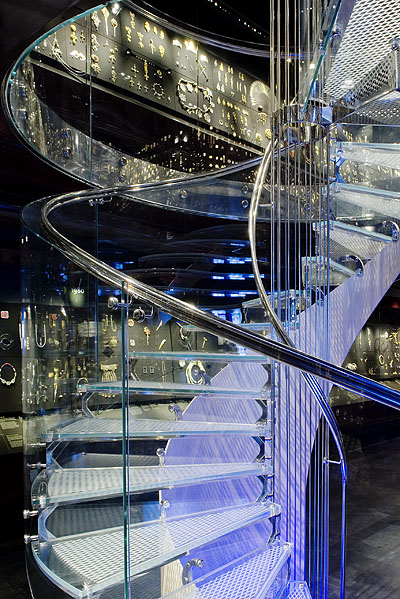
One interesting feature of this display is the large number of objects from the Royal College of Art Visiting Artists Collection. The exhibition text notes:
‘Every year from 1987 to 2006, while David Watkins was Professor of Goldsmithing, Silversmithing, Metalwork and Jewellery at the Royal College of Art, he invited four jewellers and silversmiths from outside Britain to give a week-long masterclass. The artists brought diverse skills, aesthetics and approaches. The first call on their time was to interact closely with the students. In addition, although concentrating on their teaching and working in an unfamiliar studio, each artist generously made an object for the RCA’s collection. The Royal College of Art Visiting Artists’ Collection, now transferred to the V&A, is a major document of international contemporary jewellery, a tribute to both the artists and to the vibrancy of the RCA as a teaching institution.’
Excuse me for being cynical, but it occurs to me it is also a cheap way to get a collection of international jewelry. And what about the issues of quality, or representativeness? How well do these objects stand in for the practices of the people who made them? How appropriate is it for these particular works, made during a workshop in London, to be, in many cases, the sole examples of a jeweler’s work?
Still, it would be churlish to deny the delights of this collection, which are many and varied. One particularly interesting aspect of the exhibition is the British-centric focus, a nice alternative to the continental European center that is a default setting. It is always fascinating to see how a national tradition is contextualized with the rest of the world. And while the V&A’s imperial origins and ambitions really demand that other countries outside Europe and America get a look in (the museum is, after all, a repository of the world’s decorative arts traditions, not just the trans-Atlantic) this remains a fascinating story of jewelry and offers a wealth of information and interpretation as precious and impressive as the rare materials on display.

